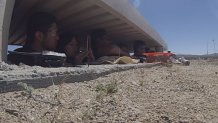With a quick countdown in the middle of the desert, a group of San Diego college students accomplished a milestone – the design, printing and testing of a 3D printed rocket engine.
Over the weekend, Students for the Exploration and Development of Space (SEDS) from UC San Diego gathered to test the engine they had created by depositing plastic or metal alloys layer by layer through a 3D printer.
The engine was secured when it was ignited. The firing lasted five seconds and used a gallon of rocket fuel.
David Nguyen, an Economics undergraduate student, said the engine passed two key tests - it didn’t explode and it didn’t melt.
The creation of engines and other rocket parts using 3D printing would have a large impact on the future of space travel.
“With our methods, we can drive down the costs of exploring space,” Nguyen said.
Also, if spare parts printed in space are found to have the same strength as those printed on Earth, it could lessen the reliance on supply missions for space stations.

The students have been funded with the help of partners like NASA and Lockheed Martin but on Tuesday they’re launching a Kickstarter campaign.
Local
“Rocket propellant fuel isn’t something you can buy at the campus store,” Nguyen explained.
They’re trying to raise $15,000 to build a Vulcan-I rocket to blast off to an altitude of 10,000 feet as part of the ESRA rocket competition in June 2015.



